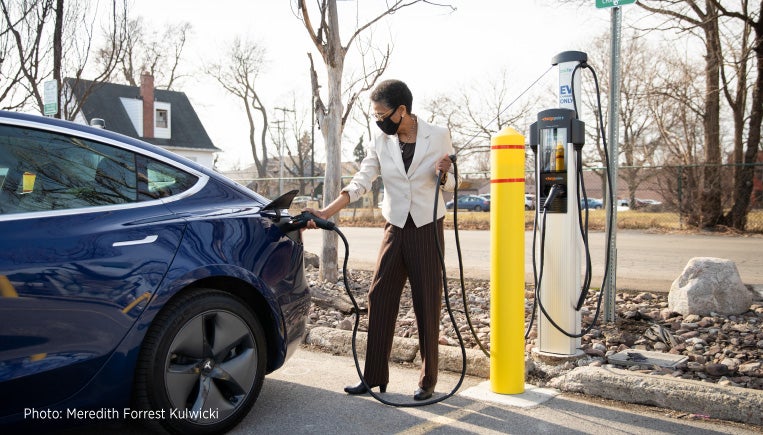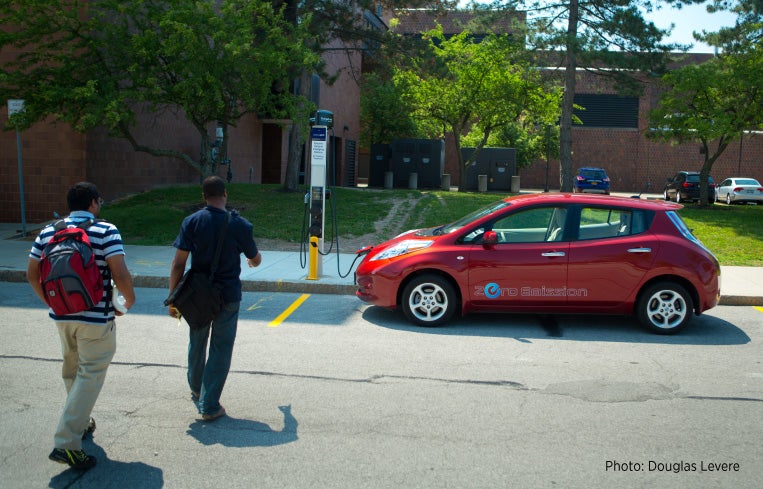ChargePoint helps University at Buffalo advance net-zero emissions goal

Founded in 1846, the University at Buffalo (UB) is the largest school in the State University of New York (SUNY) system, with more than 30,000 students, 2,500 faculty members and 5,800 full-time employees on campus every day. As a top public research university dedicated to academic excellence and making a positive impact on the world, UB has integrated sustainability into its overall strategic mission, with a heavy emphasis on climate action.
The reality of carbon neutrality
Launched in 2020, UB’s 10 in 10 initiative furthers the university’s commitment to reaching carbon neutrality by 2030. The initiative maps out 10 steps the school will take over the next 10 years to increase climate action. The steps include things like making sure all campus electricity is coming from renewable sources, adopting more sustainable heating and cooling systems, and electrifying mobility across the university. The university’s largest source of emissions comes from faculty, staff and students commuting to and from campus, as well as direct emissions from the on-campus fleet of service vehicles.
While we’re always working to nudge driving habits in a more sustainable direction, changing the culture around driving is not an easy task, even if drivers believe in our sustainability goals.

Ryan McPherson
Chief Sustainability Officer
University at Buffalo
UB’s strategy is to make it easier for commuters to choose electrification by providing on-campus EV charging infrastructure. The university is also working to electrify its own fleet.
More EVs, more charging stations
Thanks to the support of the New York Energy Redevelopment Authority, in 2013 UB implemented an EV charging pilot program to gauge interest and installed three ChargePoint® EV charging stations on the North and South Campuses for a total of six ports. Over the next few years, the number of EVs on campus skyrocketed and demand for charging was beyond what the three stations could handle. On a typical day, approximately 500 EVs commute to the university. To meet demand and further their emissions goal, UB installed 33 more charging spots at the beginning of 2021. Since then, the number of monthly EV drivers commuting to UB has increased by 206% (based on monthly driver growth from January 2021 to June 2021).
“EV charging is pivotal to our climate action strategy,” McPherson says. “About a third of our emissions right now are coming from single-occupancy vehicles. Two of the 10 initiatives that make up UB’s climate work are focused on encouraging people to drive electric as well as to use mass transit and active mobility solutions.”
Policies for handling rapid EV growth
The development of an EV charging policy was key to handling the rapid growth. UB follows a set of best practices that includes vehicle permitting policies, plug-in limits, charging rates, payment options and more. Rates increase after three hours, which allows more vehicles to rotate through the stations and gives drivers a financial incentive to move their vehicle.
“Our goal is to incentivize people to use EVs, while covering our own electricity and infrastructure maintenance costs,” McPherson says. “We can’t provide people with free power, but we can most likely provide power cheaper than what they will get at their own home because we are a large institution.”
UB is developing another policy to limit energy use during peak demand times. Higher demand during certain times of day drives up energy costs and can potentially bog down the grid, so limiting use during these peak times has multiple benefits. Many EV drivers can charge their vehicles overnight when electricity is cheaper, but university charging usually takes place during the day when energy is most expensive. McPherson and his colleagues are in the process of launching a battery storage pilot program to take advantage of lower nighttime rates as a way to offset peak-time charging.

Back-end data at work
McPherson says he and his team gravitated to ChargePoint because of the back-end tools — reports and data that show them exactly how much energy is being used, by whom and when. Having access to these analytics helped UB determine how and where to deploy the most recent EV charging infrastructure.
ChargePoint dashboards help UB keep track of energy usage and calculate their true greenhouse gas (GHG) emissions as they work to reach their 2030 goal. These tools also help McPherson and his colleagues determine whether drivers are staying plugged in beyond the three-hour limit set in their EV policy.
Having a flexible solution like ChargePoint allows UB to grow their EV charging strategy and scale as needed over time. McPherson understands that the university will eventually need to put in a lot more charging infrastructure and wants to ensure their strategy aligns with how drivers actually park and charge — all that back-end data will be key to understanding when and where to expand further.
Advice to other university sustainability officers?
McPherson is emphatic that the time to act is now. “Because of the new model options coming from auto manufacturers and federal regulations being put into place, the space has begun moving quickly,” he says.
McPherson and his team at UB took advantage of grants and other financial incentives to make the project pencil out using limited university funds. He advises university sustainability officers to think about the perspectives of the different drivers who will be using the chargers — the faculty, students and staff. Try to understand what their needs might be in terms of location as well as the policies you put into place.
I think EV charging is probably the best, most realistic strategy for getting the biggest mobility emissions reduction with the smallest amount of infrastructure and funds.

Ryan McPherson
Chief Sustainability Officer
University at Buffalo
At ChargePoint, we believe stories have the power to change the world.
Our customers share their stories because they’re passionate about all the ways the electrification of transportation has impacted their organizations. Like many companies around the globe, they’ve discovered that what’s good for the planet can also be good for business. E-mobility is here to stay. Perhaps it’s time to tell your own story.
Reach out to us at sales@chargepoint.com and let us know. We’d love to hear it.
